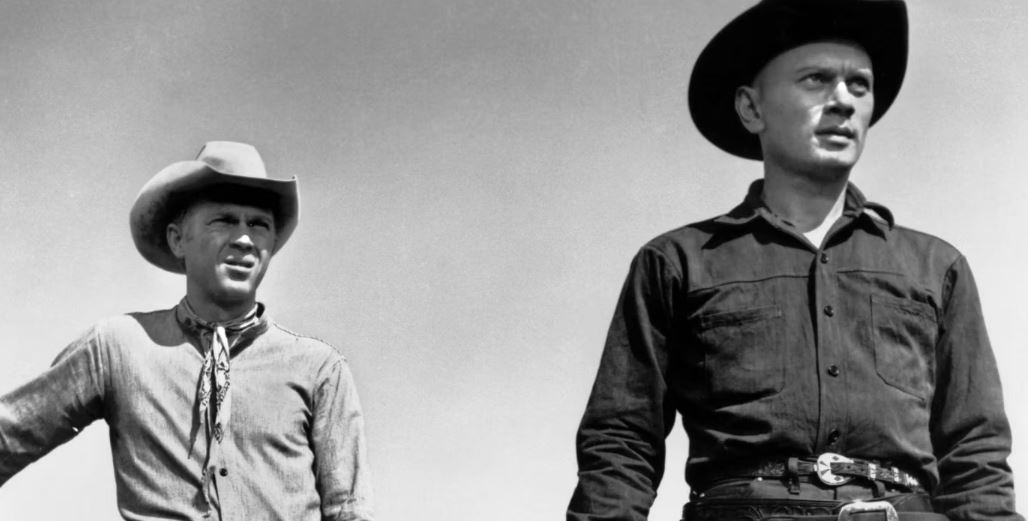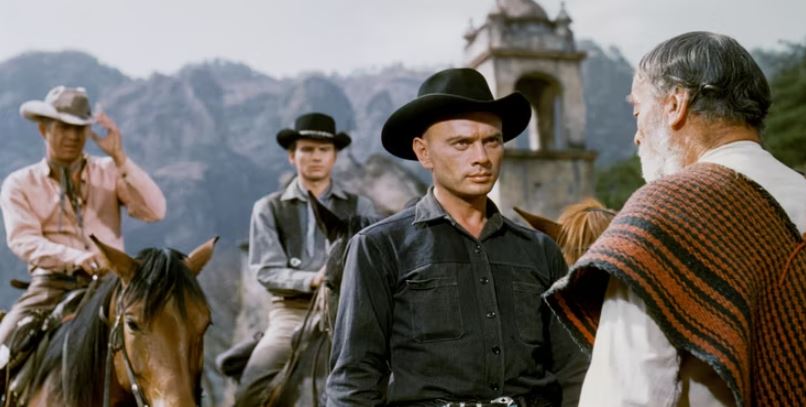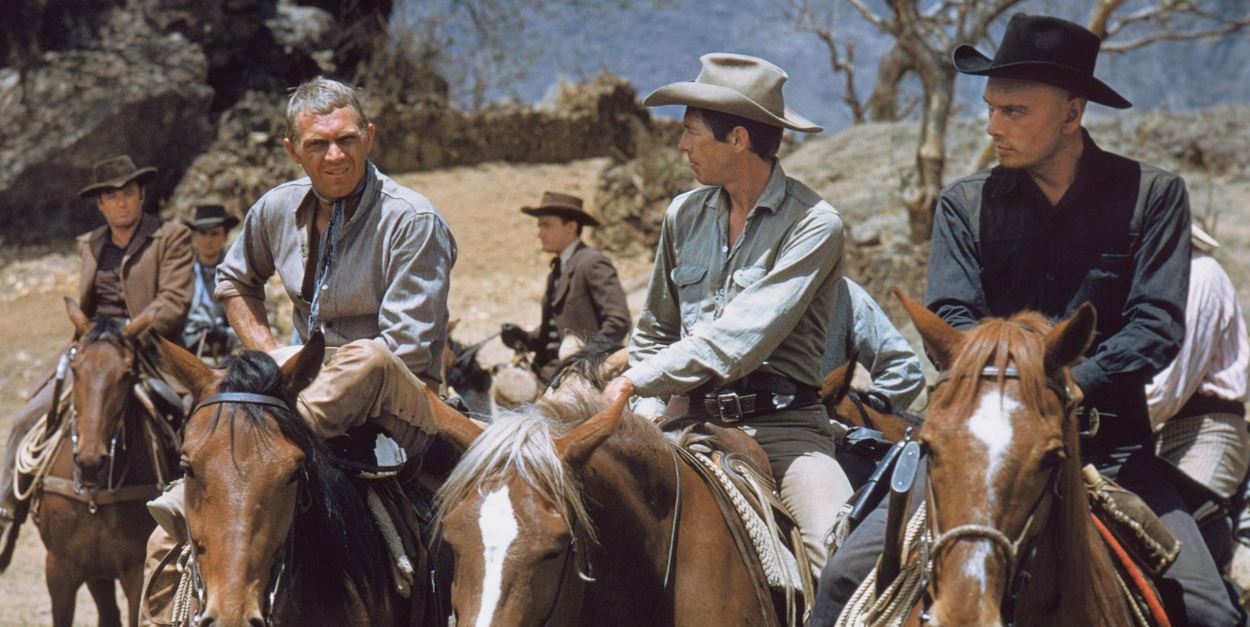Akira Kurosawa’s work has influenced cinema for generations. One of his films, Seven Samurai, inspired a wave of remakes, with John Sturges’s 1960 masterpiece, The Magnificent Seven, being the first Hollywood adaptation. But while the on-screen ensemble boasted legendary talent, off-screen egos clashed, resulting in a sizzling feud between stars Yul Brynner and Steve McQueen. According to Yul Brynner: A Biography, McQueen was displeased with the seven lines his character had in the film’s script and leveraged a more influential behind-the-scenes role offered by Sturges as a compromise.
He then subtly turned this influence into a means of drawing attention to himself, and away from Brynner, who was the lead in the film. Rattling shotgun shells during Brynner’s speech and toppling Brynner’s mound of self-built height were just a few of his tactics. Tensions simmered to a boiling point when Brynner confronted McQueen physically. This feud would go on without a resolution for years, but it was on the set of The Magnificent Seven that the feud was brewed when two stars with massive egos brushed shoulders.
What Is ‘The Magnificent Seven’ About?
The Magnificent Seven, a Western remake of Akira Kurosawa’s classic Seven Samurai, follows seven lightning-fast gunslingers hired by desperate village farmers to protect them from the ruthless bandit gang led by Calvera (Eli Wallach). Yul Brynner stars as Chris, the grizzled leader, with a stellar ensemble of co-stars including Hollywood big shots Steve McQueen, Charles Bronson, Robert Vaughn, Brad Dexter, James Coburn, and Horst Buchholz.
The story begins when farmers, weary of Calvera’s annual plunder of their crops, decide to fight back. The farmers send three representatives with valuables to buy weapons. The three witness Chris take on a risky job to defend the burial of an Indigenous American against a racist group. Chris advises them to hire gunslingers instead, as it’ll be cheaper than buying weapons. He declines their initial offer, only to accept and lead the formidable seven on the arduous task of protecting the village.

Although many consider the original Seven Samurai the pinnacle, John Sturges’ The Magnificent Seven stands out as arguably the best Hollywood version of the film and among the best Western movies ever made. Seven Samurai inspired many other movies, with the 1960 remake spawning sequels like Return of the Seven, which saw the return of the original film’s star, Yul Brynner, as the only cast from Sturges’ version, Guns of the Magnificent Seven, and The Magnificent Seven Ride!, as well as a 2016 remake by Antoine Fuqua starring Denzel Washington, Chris Pratt, and Ethan Hawke, among others. It even fueled a television series of the same name that aired on CBS from 1998 to 2000.
Steve McQueen Had a Big Ego on the Set of ‘The Magnificent Seven’
During filming of The Magnificent Seven, director John Sturges dealt with clashing competitive personalities, with Steve McQueen at the center. As per Yul Brynner: A Biography, unhappy with his seven-line role in the original script, McQueen negotiated for more lines and even a powerful behind-the-scenes position as a compromise. However, his jealousy of Yul Brynner’s leading role fueled childish pranks and attention-seeking tactics. McQueen would flip coins, rattle his shotgun shells, and even turn the camera on himself whenever Brynner was on-screen. Unbeknownst to McQueen, Brynner held significant power beyond his acting role. He had participated in acquiring the film rights and was initially considered for director before taking the lead. Yet, he never used this power against McQueen, despite the escalating pranks. The tipping point came when McQueen removed mounds of dirt Brynner had built to boost his height.
In his biography, Steve McQueen: A Biography, author Marc Elliot quotes McQueen on his part as saying, “We didn’t get along. Brynner grabbed me in front of everyone, angry about something. He doesn’t ride well and knows nothing about guns, so maybe he thought I represented a threat.” McQueen’s co-star, Robert Vaughn, echoes this sentiment in his 2008 biography A Fortunate Life, stating, “Steve was intensely competitive. It wasn’t enough just to be successful — he had to be more successful than anyone else.” Another The Magnificent Seven co-star, James Coburn, also had problems with McQueen on the film’s set.
However, Charles Bronson had a great relationship with Steve McQueen. This positive dynamic extended beyond the set, as their wives were also close friends. During his final days fighting cancer, McQueen is reported to have called Brynner telling him, “You coulda had me kicked off the movie when I rattled you, but you let me stay and that picture made me, so thanks.” Brynner forgave him and replied, “I am the king, and you are the rebel prince: every bit as royal and dangerous to cross.”

‘The Magnificent Seven’s Production Had Many Setbacks
Before cameras even rolled on The Magnificent Seven, drama galloped off the page and onto the set. Lou Morheim, a Hollywood hopeful, snagged the film’s remake rights for a mere $2,500, only to flip them to Yul Brynner’s production company for a tenfold profit. Brynner, envisioning himself in the director’s chair alongside Anthony Quinn as his leading man, set the wagon wheels in motion. But the Old West horses took a different direction, arriving with Martin Ritt replacing Brynner behind the camera and Quinn losing his grip on the reins altogether. A bitter legal battle ensued, with Quinn claiming he and Brynner had ridden the concept together, shaping the film’s details before their partnership stumbled. However, lacking a written agreement, Quinn’s accusations proved fleeting, paving the way for Brynner to lead the charge as the star of the film.
The film’s screenplay had its share of drama as well. Blacklisted writer Walter Bernstein initially penned the first draft, drawing inspiration from Seven Samurai. But when Brynner’s production took over, they brought in Walter Newman, whose work forms the majority of what appears on-screen. However, Newman couldn’t be present for filming in Mexico, so William Roberts stepped in. While Roberts’ initial task was to ensure the script would pass the censors, he ended up the sole credited writer after Newman requested his name be removed.
Another dramatic aspect of the behind-the-scenes of The Magnificent Seven was in its casting. McQueen’s casting in The Magnificent Seven was anything but straightforward. As per the biography of McQueen, Sturges, who was smitten with the actor after their collaboration on Never So Few in 1959, faced a formidable obstacle in McQueen’s ironclad contract on the TV show Wanted Dead or Alive. Undeterred, McQueen, taking a page out of his own thrill-seeking life, staged a daring car accident which made him don a convincing neck brace to break free from his television shackles. While “recuperating,” he galloped onto The Magnificent Seven set, proving once again that his commitment to a role could outrun any contract.
‘The Magnificent Seven’ Was a U.S. Box Office Bomb
While The Magnificent Seven disappointed at the U.S. box office, its international reception was a glorious stampede. Domestically, the film earned a mere $2.25 million, but across the Atlantic, it had more success. Behind the scenes, the making of the film was just as dramatic as Akiro Kurosawa’s concept, and just like the feuding egos that simmered on set, the road to this international acclaim wasn’t paved with gold nuggets. From pre-production battles over rights and roles to the birth of a feud between two Hollywood greats that lasted a lifetime, the making of this cinematic masterpiece was a drama in itself. The Magnificent Seven shows that behind-the-scenes stories can be just as intriguing (if not more) than the ones on-screen.
